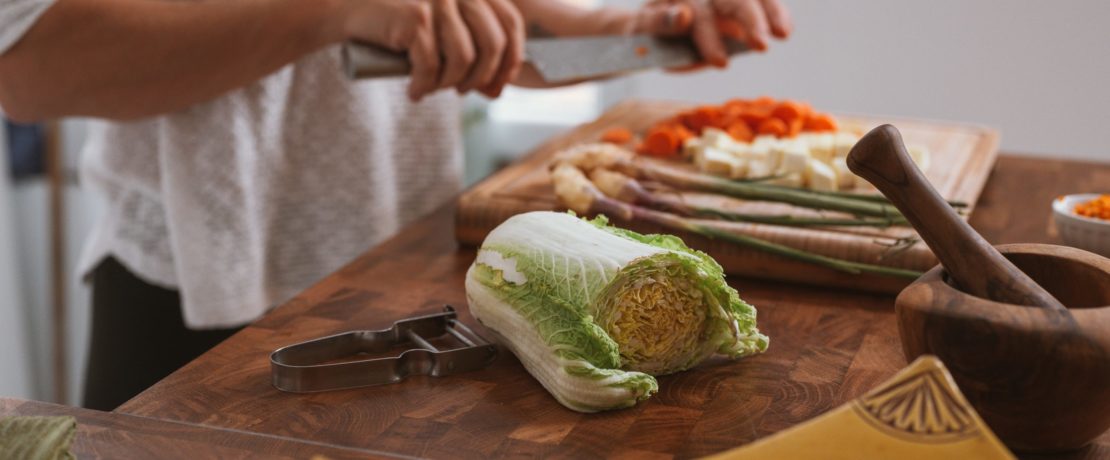Comfort food: five seasonal British recipes for autumn and winter
As the colder months advance, we asked some champions of British food to tell us about their favourite seasonal dishes that won’t break the bank.
‘A home-cooked classic’
Ameer Kotecha is a British diplomat, pop-up chef and writer on food, travel and culture. He is the author of The Platinum Jubilee Cookbook (Bloomsbury) in honour of the late Queen.
A ‘pie and a pint’ is a comforting British pub classic, and there’s also something very satisfying about baking a pie at home at this time of year. It doesn’t have to be meaty: Lord Woolton pie is an old-fashioned vegetable pie that’s economical to make, and shows off traditional British veg that often get overlooked, such as parsnips, carrots and cauliflower. Since you can use up whatever veg is available, it also helps to avoid food waste.
Named after the wartime Minister of Food, who helped promote the original recipe, the pie was filled with seasonal veg mixed with a spoonful of rolled oats, rather than meat – which was at the time in short supply due to rationing. Traditionally, the pastry topping was made with potato, flour and lard, although you could easily switch lard for butter or dairy-free margarine, or top the pie with mash instead of pastry. Serve with roast potatoes done in the same oven, and Bisto gravy, for a comforting, home-cooked classic.
Lord Woolton pie recipe
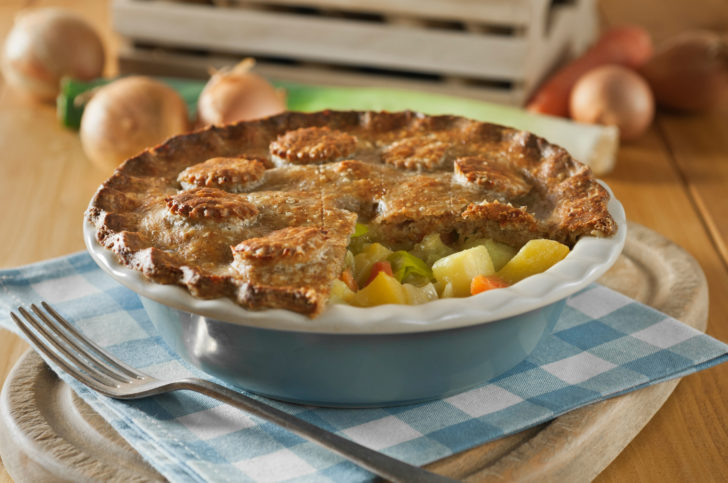
Ingredients (Serves 4)
For the pastry:
225g/8oz wholemeal flour, plus extra for rolling
2 tsp baking powder
½ tsp salt
60g/2oz fridge-cold butter (or, for an economical and authentic alternative, lard), cubed. You could also use dairy-free margarine or oil
100g/3.5oz cold mashed potato (optional)
Milk, or dairy-free alternative for glazing
For the filling:
450g/15oz potatoes, peeled and roughly chopped
450g/15oz carrots, peeled and roughly chopped
450g/15oz cauliflower, roughly chopped
1 leek, roughly sliced
2-3 spring onions, finely chopped
1 tbsp rolled oats
1 tsp vegetable or yeast extract, or 1 stock cube (optional)
Herbs of your choice (for example a couple of dried bay leaves; 1tbsp freshly chopped or 1tsp dried parsley, thyme, rosemary or lovage)
Pinch of salt and freshly ground black pepper
Method:
- To make the pastry, mix the flour, baking powder and salt together in a large bowl. Rub in the butter or lard with your fingertips. Add the mashed potato, if using, and knead together to make a soft dough, adding a splash of water if required. Wrap the dough in clingfilm and leave in the fridge for at least an hour.
- Place all the vegetables, rolled oats, the vegetable/yeast extract or stock cube and any bay leaves you’re using in a pan and barely cover with water. Bring to the boil and simmer for around 15 minutes, allowing most of the water to evaporate. Once the veg is cooked, let it cool.
- Preheat the oven to 200°C/180°C fan/gas mark 6.
- Once you’re ready to assemble your pie, roll the dough out with a rolling pin to around one eighth of an inch/3mm thickness.
- Fill a pie dish with the veg mixture and mix in any herbs you’re using.
- Cover your pie dish with your pastry crust. Brush with a little milk on top for a golden crust.
- Bake for 30-40 minutes until golden brown on top.
Tip
You could play around with fancier ingredients, such as Jerusalem artichoke, colourful heritage veg or a roasted garlic mash topping, if making it for a dinner party. Round it off with a traditional ‘school dinner’ dessert, such as rhubarb crumble or bread-and-butter pudding, for the ultimate in winter comfort food. For a more grown-up take on bread-and-butter pudding, try adding a splash of English whisky to your egg mixture before baking!
‘An all-time favourite’
Farmer and TV documentary star Amanda Owen is a keen home cook whose Yorkshire curd tart recipe and many more feature in her latest book Celebrating the Seasons with the Yorkshire Shepherdess (Pan Macmillan).
During the colder months we all enjoy a rich, indulgent treat, and Yorkshire curd tart is one of my all-time-favourite desserts at any time of year. It’s made with curd cheese, mixed with egg, currants and spices – I like to use nutmeg – baked in a sweet shortcrust pastry base. Yorkshire’s answer to cheesecake, it’s a proud staple of bakeries across the region – but if you’ve got the time, it’s also very rewarding to prepare from scratch. It’s even pretty easy to make your own basic curd (or cottage) cheese for the recipe, by simmering a pint of full-fat milk with a tablespoon of lemon juice or vinegar until curds form.
Yorkshire curd tart recipe
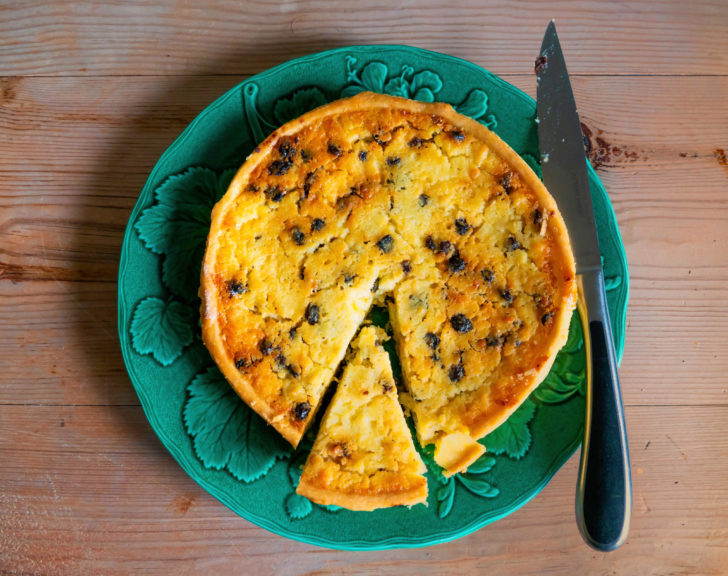
Ingredients (Serves 4)
For the pastry:
115g/4oz plain flour, plus extra for rolling
85g/3oz fridge-cold butter, plus extra for greasing
20g/0.7oz icing sugar
1 egg yolk
For the filling:
115g/4oz butter
115g/4oz caster sugar
2 medium eggs, plus 1 egg white, beaten together
200g/7oz cottage cheese
50g/1.5oz currants
Pinch of ground nutmeg
Zest of 1 small lemon
Method:
- For the pastry, sift the flour in a bowl, add the butter and rub together with your fingertips until the mixture resembles fine breadcrumbs. Stir in the icing sugar, then the egg yolk. Bring the pastry together with your hands, then wrap in cling film and chill in the fridge for 10 minutes.
- Put a baking tray on the middle shelf of the oven and preheat the oven to 200°C/180°C fan/gas 6. Grease a 21 × 2.5cm tart tin with butter. Roll out the pastry on a lightly floured surface and line the tin, then prick the base and sides of the pastry with a fork. Leave a little pastry overhanging to allow for any shrinkage when it is cooked.
- Line the pastry case with baking parchment and fill with baking beans. Cook for 15 minutes, then take the beans out and cook for a further five minutes. Allow to cool slightly, then trim off any excess pastry.
- To prepare the filling, beat the butter and sugar until soft, then add the eggs a little bit at a time, until combined. Add the cottage cheese and lightly whisk to break up any large lumps. Once blended, add the currants, nutmeg and lemon zest. Pour the curd mixture into the pastry case and cook on the middle shelf of the oven for 40-45 minutes, until the filling is set, but still has a wobble.
- Allow to cool in the tin before slicing.
Tip
The pastry can be prepared in a food processor. Add the flour, butter and icing sugar, pulse until the mixture resembles breadcrumbs, then add the egg yolk and pulse until the pastry forms. For a delicious twist, try adding a few drops of rum to the filling.
‘My ultimate comfort food’
Chef, restaurateur and food writer Mark Hix MBE owns The Oyster & Fish House in Dorset and is the author of numerous cookery books.
During the winter, I love making old-fashioned, slow-cooked dishes using ingredients like oxtail and offal. I’d like to see more people cooking with these lesser-known cuts – they’re full of flavour, affordable to buy and help make the most of our meat.
We’re fortunate to have some excellent meat producers in this country. Buying cheaper cuts such as oxtail from local suppliers and farm shops is often better value than the supermarket – and means you know exactly where your meat came from.
For me, braised oxtail is probably the ultimate winter comfort food: slow cooking oxtail pieces in a red wine braise on a very low heat or in a pressure cooker until the meat is falling away from the bone. Serve it with simple mashed swede for a delicious, hearty winter meal – although it’s too good to only make it at this time of year, and just as great with fresh green peas or beans in spring as it is with mashed or roasted root veg in winter.
Braised oxtail recipe
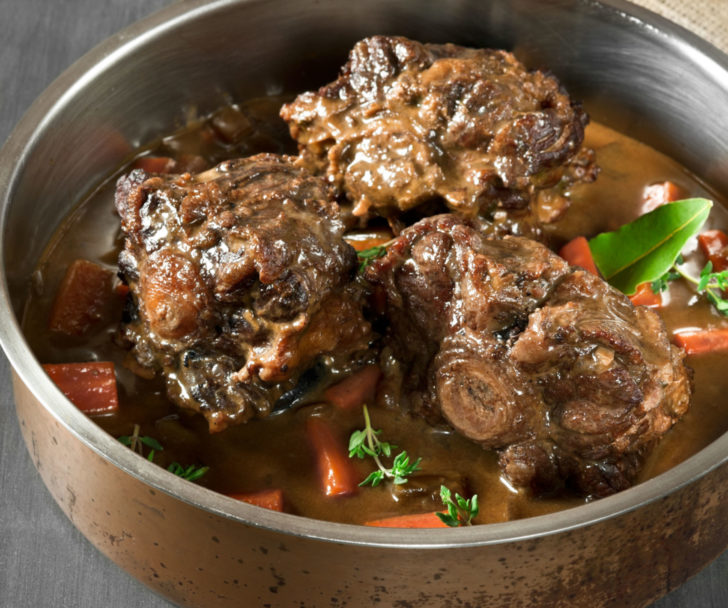
Ingredients (Serves 4):
1.5kg/53oz oxtail, cut into 2-3cm think pieces and trimmed of excess fat
Pinch of salt and freshly ground black pepper
50g/1.75oz plain flour, plus extra for dusting
A little vegetable oil, for oiling
60g/2oz butter
1 onion, peeled and finely chopped
2 garlic cloves, peeled and crushed
1t sp thyme leaves
2 tsp tomato purée
100ml red wine
2 litres beef stock
½ tbsp chopped parsley
Seasonal veg of your choice, to serve
Method:
- Preheat the oven to 220°C/200°C fan/gas mark 7.
- Season the oxtail pieces with the pinch of salt and pepper and dust lightly with flour. Place in a lightly oiled roasting tray and roast for 30 minutes, turning halfway through to make sure they colour nicely on both sides.
- Lower the oven setting to 160°C/140°C fan/gas mark 3. Meanwhile, heat the butter in a large ovenproof pan. Add the onion, garlic and thyme and cook gently for 3-4 minutes until soft, stirring every so often.
- Add the flour and tomato purée to your pan and stir well. Slowly add the red wine and beef stock, stirring to avoid lumps forming, then bring to the boil. Add the pieces of oxtail and turn to coat in the liquor.
- Cover the ovenproof pan with a tight-fitting lid, and cook for two hours in the oven. Then check the meat, which should be tender and easily removed from the bone. If it isn’t, replace the lid and cook for up to another hour.
- Skim off the fat from the sauce. If the sauce is not thick enough, strain it into another pan and simmer briskly until reduced and thickened, skimming every so often, then pour back over the meat.
- Divide the oxtail between warmed plates, spoon over the sauce and serve with the seasonal veg of your choice.
Tip
This can also be cooked in a pressure cooker. Add everything to your pressure cooker in point 3 and cook on the lowest possible heat setting (a heat-diffuser mat or simmer plate is helpful). Check the meat after about an hour. If it needs longer, leave it for another 15 minutes or so under pressure.
‘Perfect this time of year’
Emily Scott is an award-winning chef, author and creative director of Emily Scott Food in Cornwall. Her cabbage stew recipe below is taken from her debut cookbook Sea & Shore: Recipes and Stories from a Kitchen in Cornwall (Hardie Grant). Follow Emily on Instagram for more recipes like this.
One-pot suppers are a perfect way to feed your family at this time of year. I love putting a casserole dish in the middle of the table – it immediately becomes a talking point, with all the anticipation of sharing and eating together. I always think of Roald Dahl’s Willy Wonka and the Chocolate Factory when I cook this dish, although this is a lot more luxurious than the cabbage soup Charlie Bucket’s family lived off. Cabbages are under-rated and need to be celebrated, so ‘Hooray’ for cabbage stew – I promise you will love it.
Autumn cabbage stew with chipolatas recipe
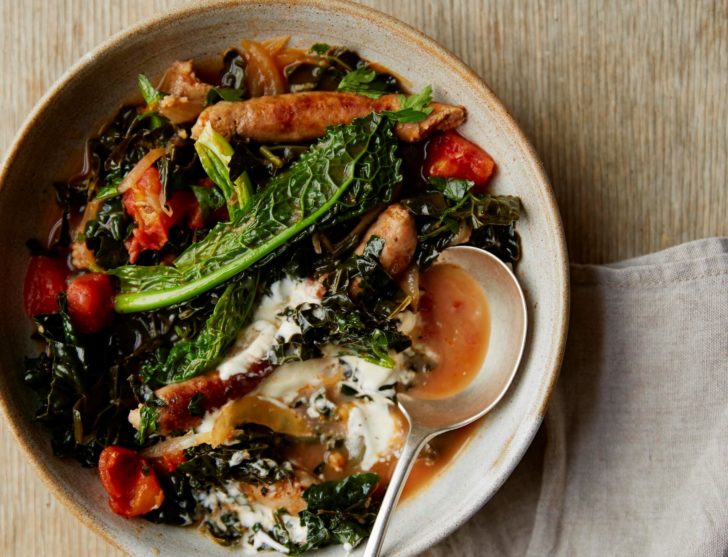
Ingredients (Serves 6):
1 large white onion
2 cloves of garlic
1 Savoy cabbage or large bag of cavolo nero
1 tin of chopped tomatoes
18 chipolata sausages (cut in half)
500ml vegetable stock
100g/3.5oz leaf parsley, roughly chopped
Pinch of sea salt and black pepper
1 tbsp crème fraiche, to serve (optional)
Method:
- Heat the onion and garlic in a large saucepan until soft.
- Add the sausages and colour until golden brown.
- Add the tomatoes and vegetable stock, sea salt and black pepper.
- Add the shredded Savoy cabbage, and simmer everything slowly for two hours.
- To serve, spoon into bowls and finish with a spoonful of crème fraiche and sprinkle with parsley.
Tip
This tastes even better the day after. I have been known to grate cheese over the top and grill it – this is particularly satisfying on a very cold day.
‘A stew bubbling away’
Cook and writer James Rich is a Somerset-born-and-bred cider maker’s son and his family have been making a living from apples for centuries. This sausage, bean and cider stew recipe features in his latest book Orchard: Sweet and savoury recipes from the countryside (Hardie Grant).
Autumn into winter is my favourite season. The cold, fresh mornings; crunchy leaves underfoot, the eery morning mist hanging low over the orchard and fields next door.
A big part of my love for these cooler months is the food; walking in from the bitterly cold outdoors into a kitchen warmed by the Aga with a stew slowly bubbling away in its belly. The heartening aromas filling the kitchen and warming your soul even before you plate it up. Earthy food: root vegetables, stock and hardy herbs steeped in some beer, cider or wine; perhaps a zest of citrus for some lift; and some locally reared meat tenderising in all the fragrant juices. Cook slowly, hour after hour, as it has been done for centuries. Serve simply with some crispy bread or perhaps some potatoes from the garden. This food isn’t complicated or ground-breaking, but it is good; so very, very good.
Sausage, bean and cider stew recipe
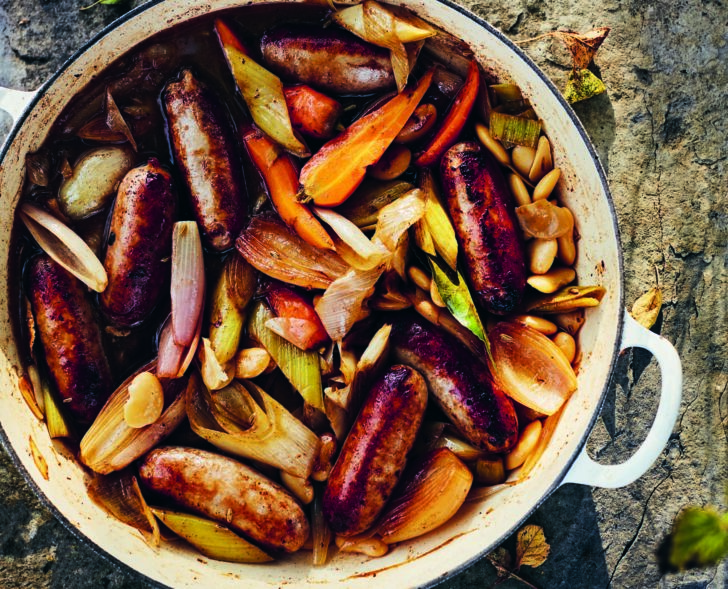
Ingredients (Serves 4):
3 tbsp olive oil or salted butter
8 good-quality pork sausages
100g/3.5oz shallots, cut in half lengthways
3 garlic cloves, sliced
150g/5oz carrots, sliced
2 leeks, sliced
1 tbsp fennel seeds
2 bay leaves
500ml/17 fl oz/2 cups dry cider
1 x 400g/14oz tin butter beans, drained
Pinch of salt and freshly ground black pepper
Crusty bread and butter or mashed potato and peas, to serve
Method:
- Heat 1 tablespoon of the oil or butter in a large, deep frying pan or casserole (Dutch oven) over a medium heat. Add the sausages and cook, turning regularly, until they are brown all over. Remove from the pan and set aside.
- Add the remaining oil or butter, then the shallots. Fry for five minutes until the shallots are starting to brown, then add the garlic and fry for a further two minutes.
- Add the carrots and leeks and fry for a further 10 minutes, until starting to soften. Add the fennel seeds and cook for a further two minutes.
- Add the bay leaves and dry cider and bring to the boil, then continue to boil for three minutes.
- Reduce to a light simmer, add the butter beans to the pan and return the sausages. Season with salt and pepper and cook for a further 35 minutes, with the lid on, until the vegetables have cooked through but still have a bit of bite.
- Serve the stew with some thick crusty bread and butter, or mashed potato and peas.
Tip
The leeks can be swapped out for any veg you have to hand, such as spring greens, kale or even purple sprouting broccoli.
